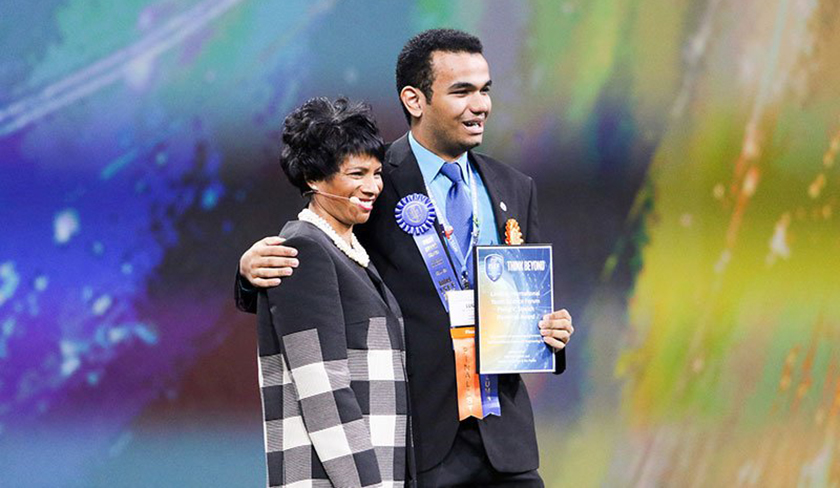Creating a new generation of prosthetics

Luiz Fernando da Silva Borges, a Brazilian high school student, is working to make it possible for those who use prosthetic limbs to recover their lost movements.
One young scientist is working on an answer: a new generation of forearm prosthetics that will enable their wearers to perform fine motor tasks like typing on a keyboard or playing the piano. Current prosthetics only allow pre-programmed movements to open, close, or point the prosthetic hand. “Because muscle activity must be read [by the prosthetic sensor(s)] before being transformed into motion, the current method makes the movements limited, slow, and not continuous,” he explained. This means, for example, that people with prosthetic forearms can’t always sense pressure or have difficulty grasping delicate objects.
Sometimes, the best technology an amputee has access to is “a heavy, clunky arm that moves slowly, can’t feel anything, and often misreads its user’s intentions,” according to a 2012 article in Wired.
He’s working on a new generation of forearm prosthetics that can perform fine motor tasks.
Luiz creates brain-machine interfaces to better control prosthetic limbs and improve their tactile feedback. Another exciting potential for this work is that it may help uncommunicative coma patients by offering a way to restore movement and sensation.
Thousands of people worldwide are wrongly diagnosed as being in a vegetative state or coma every year, Luiz explained. “I can’t imagine how much anguish and terror these people feel, being aware but unable to communicate,” he said. “I decided to give voice to all these people, extending the application [of my project] even to people anesthetized during surgery or people with brain disorders.”
Restoring amputees’ movements and sensitivities and helping people communicate is more than just solving health problems with technology, Luiz said. “It’s allowing people to regain their dignity as human beings.”
Why this high school student chases utopias
Luiz was inspired by an episode of the American television show “House” to create a way to precisely measure phantom limb movements. He uses the “continuous decoding method” of brain-machine interfaces to relate it with muscle activity on an amputee’s stump.
“The prosthesis control method makes it possible to recover most of the lost limb movements and make the hand joint and wrist movements continuous, independent, and fluid,” Luiz said.
First, Luiz worked to add continuous and independent control of hand joints in prosthetics. He needed to measure brain activity and body action, build a decoder program, and test it by plugging it into brain activity to observe how well the program could convert motor action. This approach was first done using monkey’s brain activity to control a video game.
This method makes hand and wrist movements continuous, independent, and fluid.
Luiz trained amputees in a virtual reality environment where they could control and feel movements of a virtual forearm. The amputees controlled a prosthetic’s movements in a video game format. This allowed Luiz to deliver signals of strength and temperature on the amputees’ biceps through a feedback tactile module, which made it seem like the signals were on the end of the phantom limb. This helped their brains process the information like their missing limb would have before amputation.
“I can’t reveal many details about the new computer brain-interface design because I’m still working out the technical details,” he said. “But once ready, this new paradigm will be able to help people communicate with the outside world.”
It’s allowing people to regain their dignity as human beings.
Another aspect of the interface was independent control of the prosthetic hand joints, which Luiz achieved through “continuous decodification of certain aspects of EMG signals collected from the remaining muscles in the amputee’s stump,” he said.
By adding high-resolution tactile feedback, including force and temperature, it’s possible to get rid of phantom limb syndrome, which sometimes affects amputees. Phantom limb syndrome occurs when people experience sensations, including pain, in a limb that they’ve had amputated. It causes sensations in the area where the limb would be, like it was still attached to their bodies. Luiz’s method can help amputees realize where sensations are coming from and relearn real tactile feedback.
“With my method, it’s possible to make transradial amputees recover the continuous control of more degrees of freedom than with the current method of prosthetics control, which hasn’t changed much since its creation,” Luiz said.


